Welcome to WebEngage! You’re now one step closer to becoming a Retention champion! Please press play to listen to the audio version of the blog.
Stop me if you’ve heard this one before – A bubbling tech startup enters an already competitive market.
Thanks to a novelty factor, they witness meteoric growth. In a bid to scale exponentially, they apply for funding, succeed at it and use the money from investors to acquire new customers with attractive discounts.
With a vast customer base, after exhausting funds from the first seed round, they apply for a second round, get funded, pump up their valuation numbers, and use that money to acquire more customers.
Things look steady, and the company sails smoothly for a while before they hit rough waters – Customers are churning, money is burning, investors doubt, and gaping holes start to sprout.
Without any profits to show, they resort to mass layoffs, offer risky deals on products & services, and pivot blindly to weather the storm. Unable to see the light at the end of the tunnel, they give in to ‘distress sales’ or worse – crash and burn.

In this article, we will cover:
- The Big Brand Theory
- Why Did These Companies Fail?
- When Should Brands Focus On Customer Retention?
- How To Improve Customer Retention?
- Conclusion
Think about why this happens to so many companies. There could be several reasons for failure, but the one common thread that connects these companies is – no profits.
There have been organizations that created great products which were spearheaded by incredible teams yet met with a sudden demise because they weren’t profitable. Profits are the bottom line of any business, aren’t they?
What you just read may sound like a Shakespearean tale, but that’s what most startups go through. Consider this: a staggering 90% of startups don’t make it, and among those, 20% find themselves unable to continue beyond the first year. When companies punch above their weight without the suitable means, they more often than not fall prey to what I call ‘The Inverted Hockey Stick Effect,’ a steep decline in the firm’s growth that, if mapped on a graph, looks like an inverted hockey stick. It’s a phenomenon where companies rise fast but fall faster.
The Big Brand Theory
In emerging markets like India, startup businesses are booming. There are nearly 115 unicorns in India, and a significant number hail from e-commerce, fintech, or SaaS. Brands compete to become the next big thing, but a significant chunk of those businesses go belly-up within the first year.
There have been multiple instances of companies with various business models succumbing to an inverted hockey stick effect. Here are some of them.
Jabong
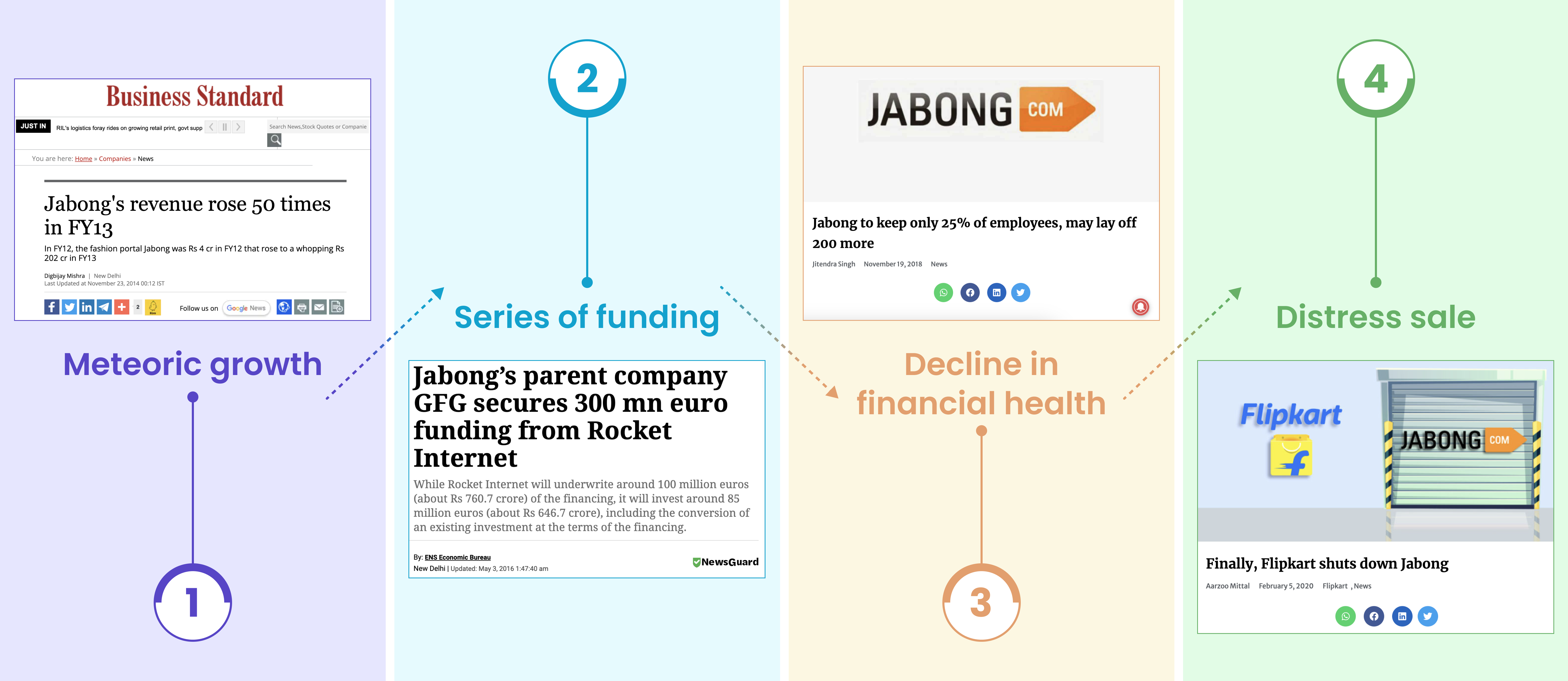
Remember Jabong, a once online lifestyle & fashion behemoth? Founded in 2012 around the e-Commerce boom, Jabong set foot in a space devoid of worldwide fashion. Its USP was that it gave Indian users unfettered access to exclusive global brands before expanding beyond apparel into sneakers, accessories, and lifestyle.
To put things in perspective, within a few months of its inception, they were garnering north of 6.4 million unique site visitors. Within a year, they were rolling out
14000 daily orders, 60% of which were from small towns. The following year, their revenue skyrocketed 50X while losses were cut by 4x. In the same year, they clocked a net revenue of Rs. 202 crores, a steep jump from Rs. 4 crores in 2011-12.
They looked primed for growth.
Cut to 2016; they were hemorrhaging money, bleeding losses, refused further investments by their lead investor, and eventually sold to their competitor Flipkart in a fire sale for $70 million.
Jabong’s wasn’t an isolated incident. Other companies met with the same fate.
LimeRoad
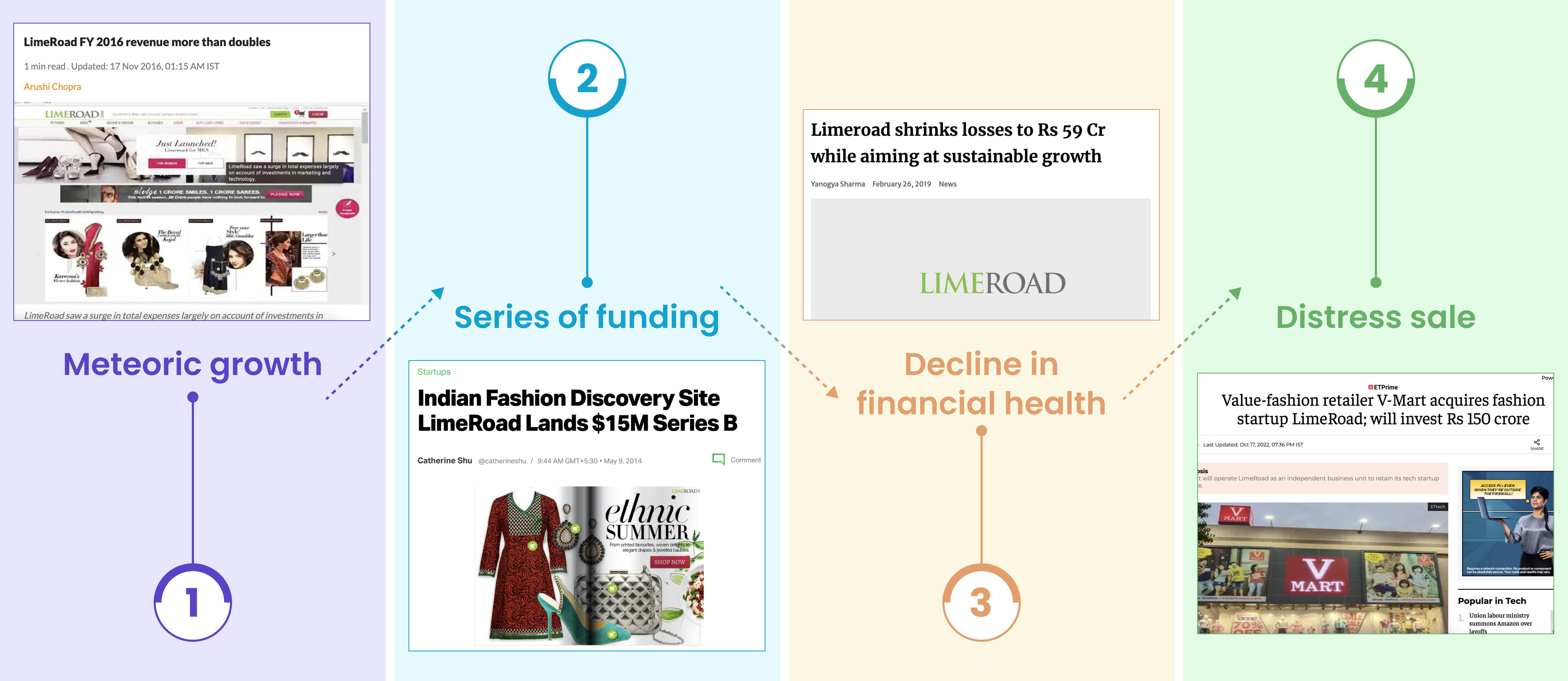
In 2012, LimeRoad, an Indian social commerce D2C company, was founded as a discovery-first women’s fashion marketplace with 750+ brands. In its heyday, the thriving startup had about 1.7 crores (17 million) unique value shoppers, with a gross merchandise value of more than Rs 700 crores.
Notwithstanding three rounds of funding by coveted investment firms, LimeRoad’s net revenue plummeted to a meager 69 crores in 2021-2022 from 179.95 crores in 2019-2020.
Cut to 2022; they were in dire straits with liabilities worth Rs 36.26 crore when they were sold to V-Mart in a distress sale for Rs.31.12 crores in an all-cash deal.
Again, LimeRoad was just one among many firms that succumbed to this unfortunate phenomenon. Let’s look at another incident.
Flyrobe
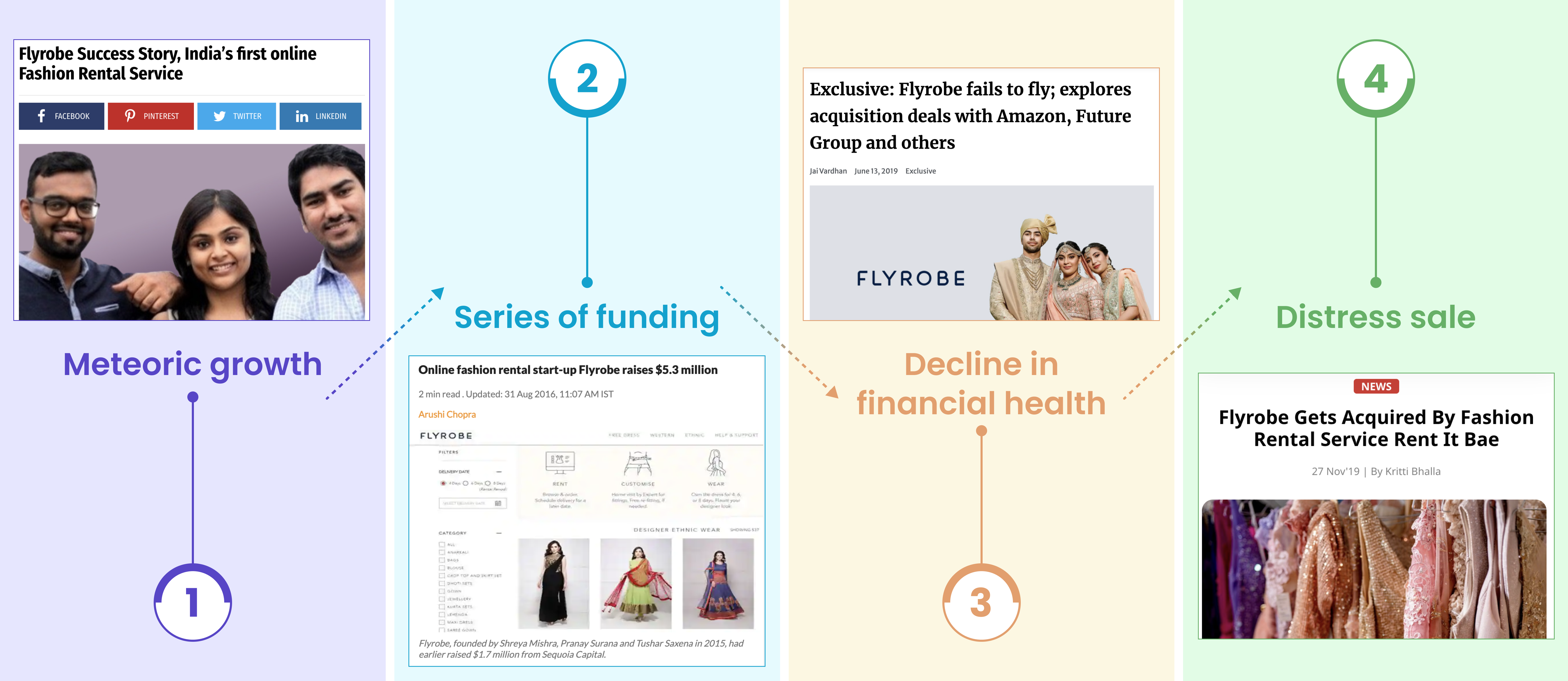
Flyrobe, the fashion startup, was one of the pioneers of Renting-As-A-Service in India. Founded in 2015, Flyrobe rented out on-demand premium designer outfits to its customers. After raising a Series A of $5.3 Million in 2016, Flyrobe was booming.
It promised to scale up to 5 times by March 2017 and was riding high on the coattails of investors who were also founders of successful companies like CRED, PayTM, Snapdeal, and Toppr.
By mid-2019, Flyrobe was struggling to make a mark in the unforgiving sharing economy. The fashion rental startup was scrambling for buyers just four years after its inception. At the end of 2019, it was acquired by Rent It Bae, another fashion rental company, in yet another distress sale.
By now, it must be clear how there is a clear pattern in the way these companies rose and fell.
Having said that, we pondered the same question you are.
Why Did These Companies Fail?
Market forces? Sure.
Bad product-market fit? Maybe.
Nonetheless, it’s hard to ignore the universal truth – they ran out of money. It’s nigh impossible for a business to stay afloat without capital.
When you burn all your capital on acquiring customers and none on retaining them, your cash flow takes a hit, and the business comes to a grinding halt.
Acquisition without retention is like filling a bucket of water that has holes.
All you’ll get is a leakage!
With retention, businesses can build and rely on a loyal community of advocates through continuous customer engagement to keep the cash flow healthy as well as turn a profit. The downside?
It is a long-term solution, and patience is the name of the game. For companies to succeed fast in the long term, they must succeed slowly in the short term.
It goes without saying that revenue comes from user spends but, more importantly, from repeat users. If you don’t have repeat users, you will eventually lose revenue. So is customer acquisition the answer? No, because customer acquisition is expensive and cuts into a company’s contribution margin.
Look at it this way – Would you rather have five customers spend ₹1000 only once on your platform or one customer repeatedly spend ₹500 every month?
More customers don’t always equal more revenue but making customers stay does. The answer lies in the 80/20 rule, more popularly known as The Pareto Principle, which posits that 80% of your profits come from 20% of your retained customers.
Customers leave your platform for the same reason they joined it – because of a fresh player advantage. Retention is not only vital but also 400% cheaper than acquisition. Therefore, for emerging companies, customer retention has, time and again, proven to be far more viable than customer acquisition.
According to a study by Bain & Co, a 5% increase in retention can boost profits by 25 to 95%. Retention may be a long-term game, but it paves the way for positive hockey stick growth. These numbers are just the tip of an iceberg that indicates how customer retention is a sustainable growth model and goes hand in hand with increased revenue.
This correlation between retention and sustainability begs a fundamental question.
When Should Brands Focus On Customer Retention?
Remember that retention is a Day-0 problem.
Most companies make the mistake of practicing customer retention once their ship starts leaking. While retention could cure such a situation, it could also prevent it.
Objective
Let us conduct an experiment to understand the economics of Retention from close quarters and how it can make almost the same money, if not more, for a fraction of the cost.
Hypothesis
There are two companies, X and Y, founded in the same year, that are direct competitors.
X acquires 1,00,000 customers MoM (Month-On-Month).
Y acquires 2,00,000 customers MoM (Month-On-Month).
| Company X | Company Y | Difference | |
| New users MoM | 1,00,000 | 2,00,000 | -1,00,000 |
Company Y acquires 2X more than Company X.
At first glance (if you’re a betting person), you’d probably bet on the success of Company Y.
Let’s look at their retention numbers.
X retains 70% of its customers.
Y retains 30% of its customers.
| Company X | Company Y | Difference | |
| New users MoM | 1,00,000 | 2,00,000 | -1,00,000 |
| Retention Rate | 70% | 30% | 40% |
X’s retention rate is more than Y’s.
A 40% difference in retention rate doesn’t seem like a big deal because Y still has twice as many customers as X. Suffice it to say Y is still leading, and your bets are safe.
Let’s look at the economics of the two companies over the course of the next 13 months.
| Company X | Company Y | Difference | |
| MAU on Month 0 | 1,00,000 | 2,00,000 | -1,00,000 |
| Retention Rate | 70% | 30% | 40% |
Hypothetical data for Company X
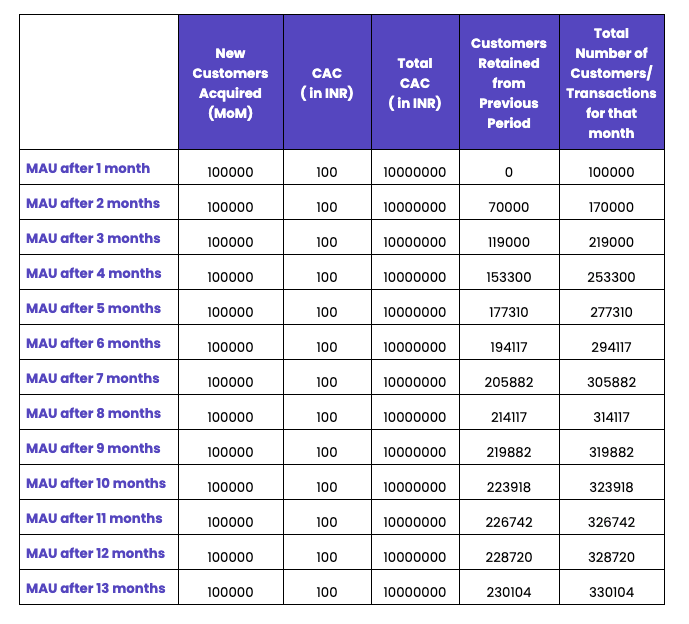
(Adjusted for decimals)
Assuming that the CAC and the AOV remain constant at 100/customer, the
Total money spent on acquiring customers = 130,000,000
Average CAC = 36
Total Revenue = Rs. 356,309,137
Profit = Rs. 226,309,137
Hypothetical data for Company Y

(Adjusted for decimals)
Assuming that the CAC and the AOV remain constant at 100/customer, the
- Total money spent on acquiring customers = 260,000,000
- Average CAC = 72
- Total Revenue = Rs. 359,183,675
- Profit = Rs. 99,183,675
Observations
- X spent half of what Y spent to acquire customers.
- X and Y’s CAC started at 100, but X’s CAC reduced to 36, whereas Y’s reduced to a mere 72, which is twice the cost of X.
- X made Rs. 12,71,25,462 in profits more than Y.
Conclusion
Thanks to a higher retention rate, X generated almost as much revenue as Y, but with 2.2X profits for a fraction of the cost within the same timeframe.
More importantly, Brand X is self-sustainable and can re-invest its profits to acquire more customers. It does not need to rely on external resources. Brand Y, however, will have a heavy dependency on investor-led growth, eventually leading to the inevitable.
This experiment, albeit successful, does leave us with a burning question.
How To Improve Customer Retention?
Here are some basic customer retention tactics to get the ball rolling.
Identify optimizable metrics
Start by outlining a list of quantifiable metrics to define what success looks like. Each brand will have its unique set of key performance indicators. There are several metrics a brand can track to measure the performance of its campaigns. Here are a few of them:
1. Customer Acquisition Cost (CAC)
The money you spend on running ad campaigns and other means that help you to acquire new customers is known as Customer Acquisition Cost. Your goal is to reduce your CAC to channel those funds toward retaining customers.
2. Customer Lifetime Value (CLV)
The money that a customer spends during the course of interaction with your business is called Customer Lifetime Value (CLTV). Optimizing CLV can also improve your retention rate.
3. Customer Churn Rate (CRC)
The percentage of users a brand loses in a given timeframe is called the customer churn rate. Reducing this percentage spikes customer retention rate.
Should you want to learn more about similar indicators, we have meticulously curated a list of trackable metrics in this blog.
Engage users
Retention and engagement are like yin and yang. To retain, you must engage. Think about it. Users won’t have a reason to stay unless you give them one. You give them a reason to stay by engaging them across various stages along the customer journey.
1. Top of the funnel (ToFU)
This is where you use engagement tactics to attract prospects to your platform by driving brand awareness, generating interest in the product, and finally acquiring them. Some ideas include the creation of
- Influencer marketing,
- Product reviews,
- Community building on social media,
- Immersive ad campaigns.
2. Middle of the funnel (MoFU)
This is where you use engagement tactics to convert prospects to users by planting a seed of consideration and intent in a potential customer’s mind. Some ideas include manufacturing gated content like
- Product explainers
- Customer testimonials,
- Newsletters,
- Experiential campaigns,
- Meet & Greets.
3. Bottom of the funnel (BoFU)
This is where you use engagement tactics to convert users to paying customers by getting them to evaluate your platform and make a decision. Some ideas include
- E-commerce: Comparative guides for consumer products,
- Travel & Hospitality: Schedule a complimentary grooming session,
- EdTech: Signing up for a free career counseling appointment.
Of course, this merely scratches the surface of funnels. To learn more, check out this blog on the types of marketing funnels tracked for improved conversions.
Improve customer experience
If you’ve ever unboxed an Apple product, you know that unboxing it is an experience. Users love it. I mean, just look at the barrage of unboxing videos on YouTube. They garner millions in views, and these channels are some of the fastest-growing YouTube channels today!
A user is unlikely to choose your brand, let alone stay with it, if your user experience is subpar. With the arsenal of tools and techniques at our fingertips, it is criminal not to have a seamless UI/UX on your platform.
When it comes to customer experience, users do judge a book by its cover. I mean, it’s a user’s world; The ground reality is that there are numerous brands to choose from, competition is fierce, each brand is jockeying for attention, and your potential customer is spoiled for choice.
Customer experience (CX) and retention go hand-in-hand.
Some notable ways to enrich CX are
1. Landing Pages/Home Screens/Onboarding screens
If you want to make a good first impression on your user, this is where you do it. To make sure your RoAS (Return On Ad Spend) improves, you need to get your users to stay on your platform after they’ve clicked on your paid ads and converted. It can also be other sections of your website/app that may drive more traction than others. The important thing to remember is to know which are those sections and optimize elements in those sections to generate conversions.
2. Support
An area where most brands are falling behind. A great product can only take you so far, but if you want your users to be there for you, you have to be there for your users. Customer support, be it manual or automated, must be woven into the fabric of your customer’s journey. 24×7 support, value-added services, and genuine empathy can go a long way.
3. Omnichannel Engagement
What use are your multiple channels if they do not complement each other for the sake of the user? Multichannel engagement no longer does the trick, but omnichannel engagement does. Through it, a brand can interact with users across predefined touchpoints and provide a holistic CX in doing so.
Hyper-personalize communications
Gone are those days when marketers would rely on the good ol’ spray and pray for conversions. Today, customers expect brands to know what they want and when they want it.
Enter hyper-personalization, which is a form of 1:1 bespoke experience for each customer. No two users have the exact wants.
How would you feel if, for Christmas, you hoped for a new gadget and got a vacuum cleaner in its stead?
That’s how users feel when they are shown the same notification without any context. Don’t believe us?
The latest statistics show that nearly two-thirds (65%) of consumers are more likely to do online research even if they plan to buy in-store, highlighting the significant role of digital engagement in purchasing decisions. Additionally, the value of personalization in retail can lead to consumers spending over 40% more than planned due to highly personalized experiences.
So what makes such intimate interactions possible?
To deliver these experiences in real-time across channels, 1:1 personalization requires rapid data aggregation and analysis, cross-channel deployment, and machine learning built on complex neural networks.
Such experiences are powered by sophisticated algorithms hardcoded into intelligent engines. Although there are many engines on the market, allow us to illustrate with the help of the Catalog and Recommendation engine by WebEngage.
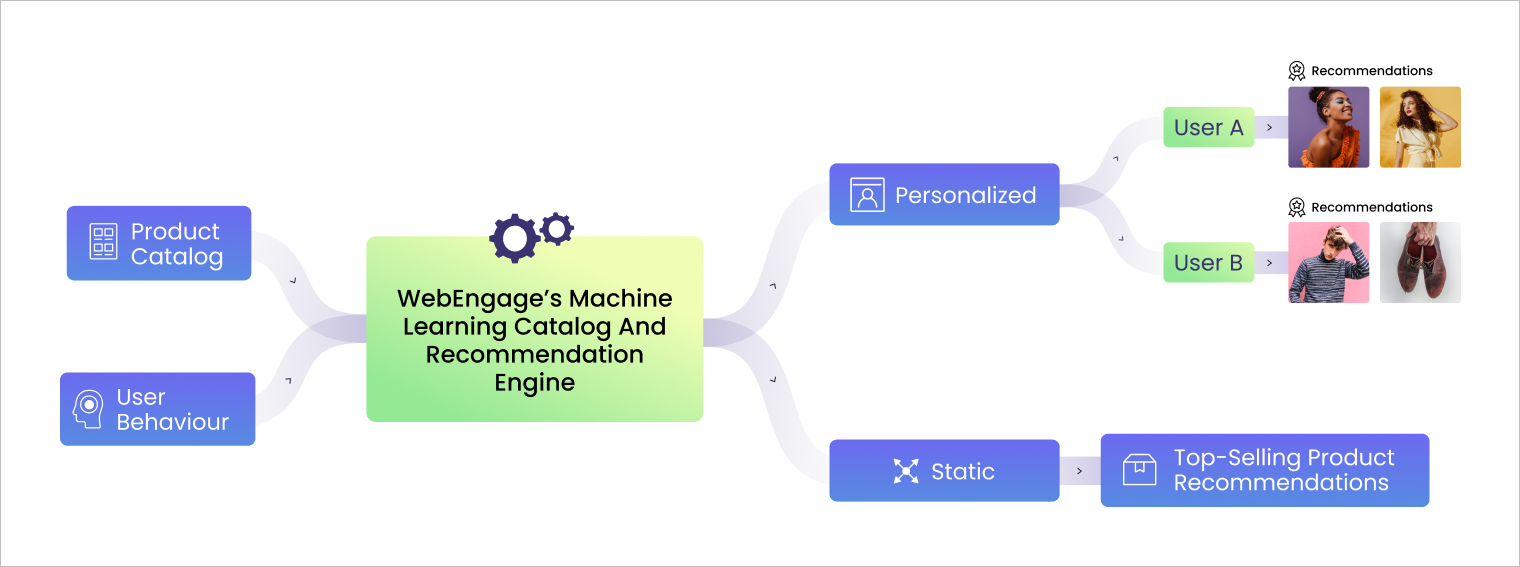
This engine has two moving parts: a catalog and a recommendation engine.
Catalog
Keep all your product info in one place and leverage that information to send communications only to the user. An example would be getting the latest discounted price for a product from a Catalog instead of the old retail price.
Recommendation Engine
Personalize your messaging with recommendations based on your users’ actions. For example, if a user purchases shorts, you can use our recommendation engine to suggest other products that the user might be interested in purchasing.
Thanks to such engines, hyper-personalization has made its mark on several industries.
4. Proactive Customer Service
Proactive customer service is about anticipating your customers’ needs and addressing them before they even have to ask. Here’s how you can nail this approach:
1. Timely Problem Resolution:
- Preemptive Contact:Use predictive analytics to spot issues before they affect your customers. For example, if you notice a common glitch in a product, reach out with a fix before it frustrates your customers.
- Real-Time Monitoring:Constantly monitor for potential issues and address them immediately to prevent escalation.
2. Regular Updates and Information Sharing:
- Newsletters and Updates:Send out updates to keep your customers informed about what’s new. This keeps everyone feeling connected and appreciated.
- Personalized Alerts:Notify customers about service interruptions or maintenance schedules, ensuring they’re aware ahead of time.
3. Educational Content:
- Guided Tutorials and Tips:Share guides or videos to help customers use your products or services more effectively.
- FAQ Updates:Regularly update your FAQs with new information to address common questions before they’re even asked.
4. Feedback Solicitation:
- Surveys and Feedback Forms:Actively seek feedback to understand your customers’ experiences and areas for improvement.
- Follow-up Calls:After resolving an issue, make a quick call to ensure they’re satisfied with the solution.
5. Customer Journey Optimization:
- Journey Mapping:Regularly revisit the customer journey to identify and smooth out any bumps.
- Customized Recommendations:Use customer data to provide personalized product or service recommendations before the customer even realizes they need them.
Implementing these strategies requires a mix of technology, training, and a culture oriented toward customer satisfaction. According to a report by HubSpot, companies that excel in proactive customer service see higher satisfaction rates and increased customer loyalty.
5. Community Engagement
Building a strong community around your brand is about creating meaningful connections. When customers feel like they’re part of a tribe, their loyalty deepens, and they become advocates. Here are three effective ways to foster this sense of belonging:
Online and Social Media Engagement
- What It’s All About: Online forums and social media groups are like neighborhood gatherings and exclusive clubs where people chat, share stories, give advice, and get VIP access to new products and discussions.
- How to Make It Happen:Use platforms like Discourse or vBulletin for forums and Facebook Groups or LinkedIn Groups for social media. Create engaging, tailored spaces for your community.
- Impact:According to data from CMX Hub, 58% of businesses using online communities report increased customer satisfaction. Insights from Sprout Social indicate that brands with active social media communities see a 21% increase in customer retention.
Regular Virtual Meet-Ups and Exclusive Content
- What It’s All About:Host fun, interactive sessions like Q&As, workshops, or virtual appreciation parties, and offer special content and perks to your community, like early access or exclusive insights.
- How to Make It Happen:Use tools like Zoom or Google Meet for events and deliver perks through email newsletters or community platforms.
- Impact:Virtual events boost community engagement by 40%, and exclusive content increases the likelihood of customers becoming brand advocates by 37%.
Feedback and Co-Creation Opportunities
- What It’s All About:Involve your customers in the creation process through crowdsourcing ideas or innovation challenges.
- How to Make It Happen:Use platforms for crowdsourcing or simple tools like surveys and social media polls to gather insights.
- Impact:Companies engaging customers in co-creation see up to a 50% increase in customer loyalty and a 30% increase in the speed of innovation, as reported by Nielsen.
By strategically implementing these community engagement tactics, brands can not only increase customer loyalty but also gather invaluable insights that drive product innovation and business growth.
Conclusion
Brands today are sidelining retention by only strengthening their acquisition muscle instead of upping their retention game.
The ideal retention rate may vary from sector to sector, but here is a benchmark for average retention rates across industries.
Moreover, retention comes with a host of benefits.
- It is 7 times cheaper than acquisition,
- Increases customer lifetime value,
- Breeds loyalists & advocates,
- Boosts revenue,
- Leaves more capital to reinvest & pivot,
- Acts as a sustainable growth model.
If you are unsure where to begin, here’s our customer retention calculator to get you started.
Easily calculate your most important metrics using our ready-to-use calculator. Download now!
Retention, or lack thereof, can make or break your business. In today’s fiercely competitive market, it is a dialogue companies should be engaging in to build long-lasting brands and an airtight community of faithful customers.
It is, after all, the secret sauce in The Big Brand Theory.
FAQs
What is the concept of customer retention?
Customer retention refers to the strategies and actions that businesses undertake to encourage their existing customers to continue using their products or services. This concept is based on the understanding that keeping an existing customer is generally more cost-effective than acquiring a new one. Effective customer retention involves maintaining high customer satisfaction, fostering loyalty, and creating ongoing value that keeps customers engaged and committed to the brand.
What are the aims of customer retention?
- Increasing Customer Lifetime Value (CLV): By retaining customers, companies aim to maximize the revenue generated from each customer over the duration of their relationship.
- Reducing Churn Rate:Lowering the percentage of customers who stop using the business’s products or services is a key objective, as it directly impacts the company’s revenue stability.
- Building Brand Loyalty:Retention strategies aim to deepen customers’ emotional and psychological ties with a brand, encouraging repeat purchases and referrals.
- Gaining Competitive Advantage:Companies that excel in retaining customers often differentiate themselves in competitive markets, leading to sustained business growth and profitability.
How do you solve customer retention problems?
Solving customer retention problems involves several strategic steps:
- Identify the Causes of Churn:Through data analysis and customer feedback, identify why customers are leaving. Common reasons include poor customer service, lack of perceived value, or competitive offers.
- Improve Customer Engagement:Regularly interact with customers through various channels and touchpoints to keep them informed and engaged. Personalization of communications and offers can significantly enhance engagement.
- Enhance Customer Support:Provide reliable, accessible, and empathetic customer service. This includes offering multi-channel support and ensuring that customer issues are resolved quickly and effectively.
- Offer Value:Continuously innovate and improve the product or service to ensure it remains valuable and relevant to your customers. This could involve updates, improvements, or new features based on customer input and market trends.
- Foster Community:Build a sense of community among customers through forums, social media groups, or loyalty programs, giving customers more reasons to stay engaged with the brand.































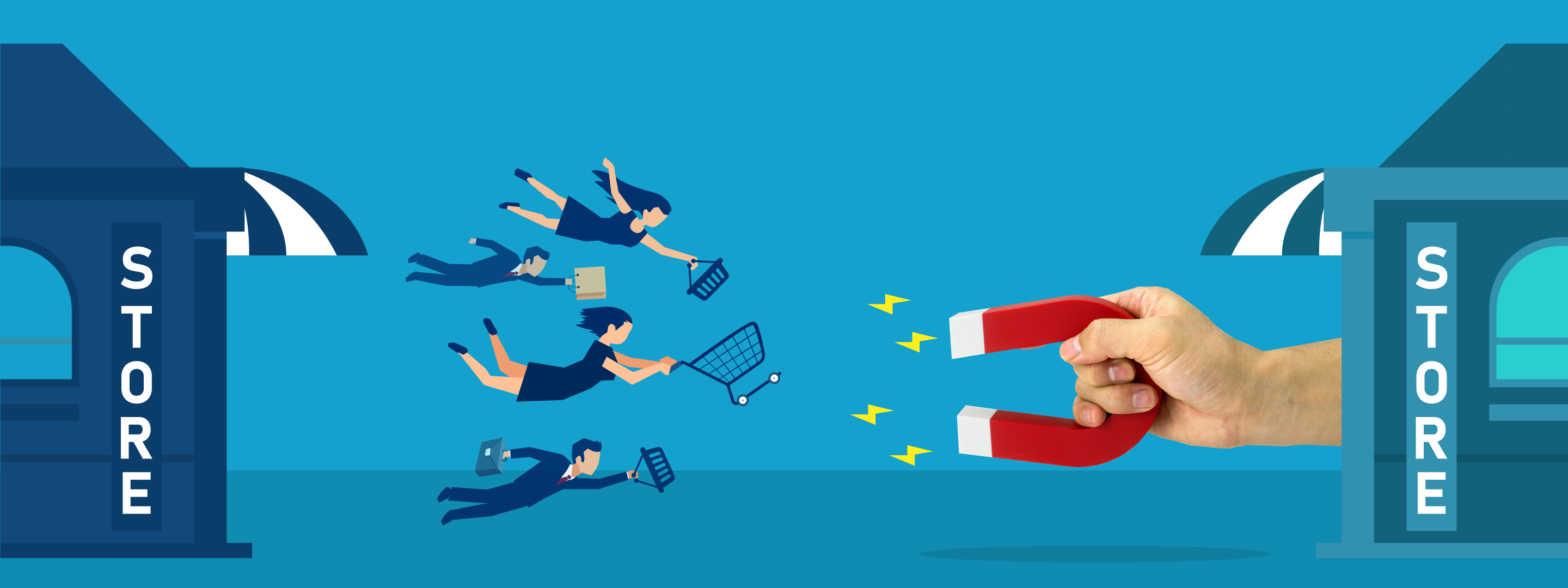


 Inioluwa Ademuwagun
Inioluwa Ademuwagun
 Ananya Nigam
Ananya Nigam
 Harshita Lal
Harshita Lal